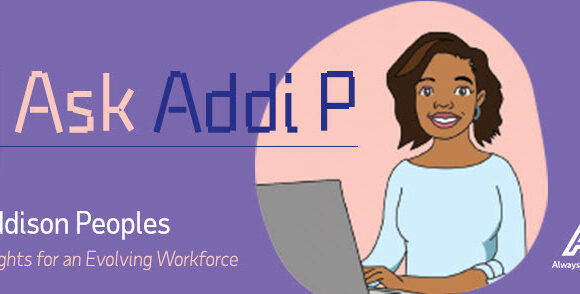Untitled RSS Feed
<p>Difficult conversations with employees come with the territory of being an employer. However, the challenges brought upon by the COVID-19 pandemic has taken this to a new level. Whether it’s about potential exposure to COVID-19, a pay freeze or furlough, or some other issue, these conversations must be handled consistently and with care. Here are some general guidelines for having difficult conversations as well as a few scenarios to consider.</p>
<p><strong>General Guidelines:</strong></p>
<p>Here are some general guidelines for handling these types of conversations:</p>
<ul type=”disc”>
<li><strong>Be proactive.</strong> Take steps to help prevent problems from occurring in the first place. Use an <a href=”https://sbshrs.adpinfo.com/blog/15-must-have-hr-policies-and-forms” target=”_blank” rel=”noopener noreferrer”>employee handbook</a> and regular staff meetings to clearly communicate workplace rules and procedures so that employees know exactly what is expected of them.</li>
<li><strong>Address the issue promptly.</strong> If you have reason to believe that an employee violated company policy, immediately gather the facts, conduct a prompt investigation where necessary, and meet with the employee as soon as possible. Addressing the issue early on can prevent it from becoming worse, leading to even more difficult conversations in the future.</li>
<li><strong>Have a private conversation with the employee.</strong> Schedule a conversation between the employee and a manager or HR representative who has the training and experience to handle difficult conversations. Prior to the COVID-19 pandemic, a face-to-face conversation was generally considered a best practice for such conversations, but employers must now consider whether an in-person conversation is necessary given the situation. When an in-person meeting isn’t required, schedule a video conversation with the employee. For disciplinary or termination meetings, consider having another manager act as a witness to the conversation.</li>
<li><strong>Be empathetic but straightforward.</strong> Let employees know that you understand the information you deliver may be difficult to hear, but don’t dance around the issue. If an employee violated company policy, clearly tell them exactly what the problem is, what steps they must take to correct it, and the consequences of failing to do so.</li>
<li><strong>Give the employee an opportunity to speak.</strong> During the meeting, give the employee an opportunity to comment and ask questions to ensure they fully understand the issue.</li>
</ul>
<p><strong>Scenarios:</strong></p>
<p>Below are several scenarios that may necessitate difficult conversations during the pandemic.</p>
<p><strong>#1: An employee tests positive for COVID-19 and you want to inform those who have had close contact.</strong></p>
<p>If an employee is confirmed to have COVID-19, inform other employees of their possible exposure to COVID-19 in the workplace but maintain confidentiality (that is, don’t reveal who has the illness). The Americans with Disabilities Act (ADA) requires employers to keep all medical information confidential, even if it isn’t about a disability. Many states may have similar laws.</p>
<p>Provide the close contact with federal, state, local, and company rules and guidelines for these situations. For instance, the Centers for Disease Control states that anyone who has had close contact with someone with COVID-19 should stay home for at least 14 days from the last contact and watch for symptoms. If applicable, let the close contact know they’ll be allowed to work from home. If the employee is unable to telework and is entitled to leave under applicable laws or company policy, notify the employee of these rights (some leave laws require such notice).</p>
<p><strong>#2: An employee calls in sick during the pandemic and you want to protect other employees from potential exposure to COVID-19.</strong></p>
<p>During a pandemic, federal law allows employers to ask employees if they’re experiencing symptoms of the pandemic virus. Therefore, under federal law, if an employee calls in sick, you may refer to the latest federal, state, and local guidelines on COVID-19 symptoms and ask whether the employee is experiencing each symptom.</p>
<p>If the employee has any of the COVID-19 symptoms, follow applicable federal, state, and local rules and guidance and let the employee know what steps they need to take before they return to work.</p>
<p>Maintain all information about employee illness as a confidential medical record in compliance with the ADA.</p>
<p><strong>#3: An employee is violating dress and grooming policies.</strong></p>
<p>During the pandemic, many employers have relaxed their dress codes, but some employees may take it too far or the stress of the pandemic could result in poor hygiene, body odor, and other issues. In either case, this can have a negative effect on clients, customers, and co-workers. Consider these guidelines for addressing this type of issue:</p>
<ul type=”disc”>
<li><strong>Be tactful but direct.</strong> Set the stage by letting the employee know that you plan to discuss a difficult topic. In some cases, the employee may be unaware that a problem exists and may need specific information about what the problem is. Provide an explanation of the issue, treating the employee with respect. Use factual terms and avoid judgmental language. Cite your policy (if applicable) and describe how the employee’s conduct is affecting the business.</li>
<li><strong>Understand workers’ rights.</strong> Under Title VII of the Civil Rights Act, the ADA and similar state laws, employers may be required to make <a href=”https://sbshrs.adpinfo.com/blog/an-employee-asked-for-an-accommodation-now-what” target=”_blank” rel=”noopener noreferrer”>reasonable accommodations</a> for individuals with disabilities, and for an employee’s sincerely held religious beliefs and practices, unless it creates an undue hardship on the business. For example, an employer that requires employees to be clean-shaven might need to make an exception for individuals who maintain beards as part of their religious practices.</li>
<li><strong>Never assume you know the cause.</strong> Hygiene problems may be caused by a variety of factors, including medical issues, cultural differences, mental health issues, personal problems, or poor grooming habits. Never assume that any one of these factors is the cause and be mindful of nondiscrimination laws when addressing a hygiene issue.</li>
<li><strong>Set expectations and document.</strong> At the end of the meeting, clearly communicate your expectations and next steps. Document the conversation, what actions need to be taken to address the issue, and the potential consequences of failing to rectify the issue. If an accommodation is the solution, document the discussion with the employee, the possible options for accommodation, and how the accommodation will be implemented. Once implemented, periodically check in with the employee to ensure that the accommodation is effective.</li>
</ul>
<p><strong>#4: Pay raises won’t be provided this year.</strong></p>
<p>If you typically give annual pay increases but are unable to, consider these tips to help manage employee morale:</p>
<ul type=”disc”>
<li><strong>Set expectations.</strong> While employees may be accustomed to annual pay raises or bonuses, explain that they are not guaranteed each year. Avoid language that implies that employees automatically receive a bonus or increase and communicate the factors the company considers before awarding pay increases.</li>
<li><strong>Use a multi-pronged approach.</strong> When a pay freeze is necessary, be straightforward with employees about the difficult situation the company is facing. Consider announcing the freeze as early as possible and then follow up with each affected employee.</li>
<li><strong>Explain that you considered other options.</strong> Acknowledge that the decision was difficult for the company and that you considered all available options before reaching your conclusion. Where appropriate, consider asking employees for ideas to help improve business processes and reduce costs.</li>
<li><strong>Look for other ways to recognize employees.</strong> If you’re unable to give merit increases, you can still recognize employee performance in other ways, such as an “Employee of the Month” program, an announcement in company communications, a note from a supervisor, or special privileges.</li>
</ul>
<p><strong>#5: A furlough or layoff is necessary.</strong></p>
<p>Here are some guidelines for communicating with employees about furloughs and layoffs:</p>
<ul type=”disc”>
<li><strong>Comply with notice requirements.</strong> Several laws may govern what type and how much notice employers need to give their employees prior to a furlough, layoff, or plant closing. Due to COVID-19, states may suspend or alter these requirements. Additionally, some states require advance notice of any reduction in pay. Absent a specific notice requirement, provide as much notice as possible.</li>
</ul>
<p><strong>Note:</strong> Some <a title=”February State and Local Legislative Updates” href=”https://www.adp.com/spark/articles/2021/02/february-state-and-local-legislative-updates.aspx” target=”_blank” rel=”noopener noreferrer”>states and local jurisdictions</a> have enacted predictive scheduling laws. These laws generally require employers to follow certain scheduling practices, including providing a certain amount of advance notice before making changes to employees’ schedules. Be sure to check to see if you are subject to such a law. Some jurisdictions, including <a href=”https://www.oregon.gov/boli/TA/docs/COVID19_Predictive%20Scheduling.pdf” target=”_blank” rel=”noopener noreferrer”>Oregon</a>, are providing guidance on these laws in light of COVID-19.</p>
<ul type=”disc”>
<li><strong>Be clear, concise, and compassionate.</strong> Keep in mind that employees may not know what a furlough or layoff means, and there is no universal definition of these terms. Clearly and concisely describe the action you are taking in terms your employees will understand. For instance, “as a result of a decline in business activity, we are requiring employees to take unpaid time off. Your unpaid time off will start on [Date] and is anticipated to end on [Date]. During this time, you won’t be permitted to perform any work for the company. Unfortunately, because there is still a significant amount of uncertainty, this end date may change and isn’t guaranteed.” Also be compassionate in delivering the news by stating that you know this will have a significant impact on them and that you considered alternatives before reaching your conclusion.</li>
<li><strong>Address final pay and benefits.</strong> Be prepared to provide information about the employee’s <a href=”https://sbshrs.adpinfo.com/blog/final-pay-when-is-it-due-what-does-it-include-more” target=”_blank” rel=”noopener noreferrer”>final pay</a> and benefits during the meeting if applicable. There are federal and state rules for providing final pay and certain notices to employees. Additionally, depending on your state, you may be required to include accrued, unused vacation and paid time off in the employee’s final pay. Some states have final pay laws that may be implicated by a furlough. Generally, though, short-term furloughs with a definite return date (that is clearly communicated to employees) don’t trigger final pay requirements. Thus, any pay owed to the employee would be due on their next regular payday. However, some states may have stricter rules. For example, in California, a furlough longer than 10 days or a normal pay period (if shorter) should be considered a layoff. If it is a layoff, final wages and all accrued but unused vacation and PTO must be paid out immediately. Make sure you comply with all applicable requirements.</li>
<li><strong>Provide separation information.</strong> Several states require employers to provide a separation notice detailing, among other things, the reason for, and date of, the separation. In some cases, these notices are given directly to the employee. Other states require employers to send the notices directly to the state unemployment agency. Some states also require employers to provide written information about unemployment compensation and other benefits at the time of separation <a title=”My Organization Has Furloughed Employees — What Do I Need to Know About Their Benefits?” href=”https://www.adp.com/spark/articles/2020/11/ask-addi-p-my-organization-has-furloughed-employees-what-do-i-need-to-know-about-their-benefits.aspx” target=”_blank” rel=”noopener noreferrer”>or furlough</a>. Check your state requirements to ensure compliance.</li>
</ul>
<p><strong>Conclusion:</strong></p>
<p>Before having a <a title=”How Do I Manage Important Employee Communications in Today’s Work Environment?” href=”https://www.adp.com/spark/articles/2020/10/ask-addi-p-how-do-i-manage-important-employee-communications-in-todays-work-environment.aspx” target=”_blank” rel=”noopener noreferrer”>difficult conversation</a> with an employee, make sure you have carefully planned not only what information you need to convey but also how you will deliver it.</p>
<p><strong><em>Get more insights and best practices by visiting our <a href=”https://sbshrs.adpinfo.com/covid19″ target=”_blank” rel=”noopener noreferrer”>COVID-19 Small Business Resource Center</a>.</em></strong></p>
<p><em><strong>Get customizable email templates and in-depth information on direct deposit, recent legislation and other valuable topics in the <a href=”https://adp-com-prod.es.ad.adp.com/resources/articles-and-insights/articles/c/covid-19-employee-communications-toolkit.aspx” target=”_blank” rel=”noopener noreferrer”>COVID-19 Employee Communications Toolkit</a>.</strong></em></p>
<p><sub><em>This article was originally published as an “ADP HR Tip of the Week” which is a communication created for ADP’s <a href=”https://www.adp.com/who-we-serve/by-business-size/1-49-employees.aspx” target=”_blank” rel=”noopener noreferrer”>small business</a> clients.</em></sub></p>
<p class=”tags”>
Tags:
<a href=”https://www.adp.com/spark/tags.aspx?tag=Leadership&id=9408e6b8-eaa4-475f-8006-2645ae8bb058″>Leadership</a>
<a href=”https://www.adp.com/spark/tags.aspx?tag=Company Culture&id=292b8804-7b23-4d3e-b426-48eda4132f9c”>Company Culture</a>
<a href=”https://www.adp.com/spark/tags.aspx?tag=Small Business&id=11e9414b-dd28-4511-9242-a7e46a7cd5a2″>Small Business</a>
<a href=”https://www.adp.com/spark/tags.aspx?tag=HR&id=63c6e53c-e07b-4cf2-9a53-2415efc58cd1″>HR</a>
<a href=”https://www.adp.com/spark/tags.aspx?tag=Change Management&id=ee0cdd4b-a0eb-4822-8ca6-114010f76be8″>Change Management</a>
<a href=”https://www.adp.com/spark/tags.aspx?tag=Articles&id=b2e0ef59-e6a0-4d9b-80de-68bbfd2e6110″>Articles</a>
<a href=”https://www.adp.com/spark/tags.aspx?tag=People Management and Growth&id=8585991f-c7aa-4894-b279-1105733787d1″>People Management and Growth</a>
<a href=”https://www.adp.com/spark/tags.aspx?tag=Employee Handbook&id=9d0c56ce-ff4a-4f7e-a90c-0f0200935d2b”>Employee Handbook</a>
<a href=”https://www.adp.com/spark/tags.aspx?tag=Midsize Business&id=93017f90-94ad-4e56-8655-35e46b9d7aca”>Midsize Business</a>
<a href=”https://www.adp.com/spark/tags.aspx?tag=Business Owner&id=b157d401-6b35-4667-9737-d8dda961638a”>Business Owner</a>
<a href=”https://www.adp.com/spark/tags.aspx?tag=Benefits Administration&id=5ca29f5d-6c0b-463c-aa7e-09d00b1dedf5″>Benefits Administration</a>
</p>
<p><strong><a href=”https://blockads.fivefilters.org”></a></strong> <a href=”https://blockads.fivefilters.org/acceptable.html”>(Why?)</a></p>
<p>When organizations shifted to working remotely because of COVID-19, everyone’s immediate focus was on establishing work-from-home infrastructure: ensuring your employees had the technology and processes they needed to be effective.</p>
<p>As organizations continue to evolve to meet the needs of new and existing employees balancing multi-generational households, remote work and the desire for location independence, it’s important to ensure your leaders are prepared. Providing managers guidance on effective hiring, onboarding, interviewing and other talent essentials is crucial to ensuring engagement, growth, satisfaction and retention of employees.</p>
<p>From a recent <a title=”U.S. Workers Discovering Affinity for Remote Work” href=”https://news.gallup.com/poll/306695/workers-discovering-affinity-remote-work.aspx” target=”_blank” rel=”noopener noreferrer”>Gallup poll</a>, “three in five U.S. workers who have been doing their jobs remotely from home during the coronavirus pandemic would prefer to work remotely as much as possible…” Indicating that the employers should consider embracing a remote workforce as a long-term model.</p>
<p><strong>Driving engagement from day one</strong></p>
<p>For years, new and existing employees have asked to work remotely. Among other factors, they value the flexibility, autonomy, work-life balance, location independence and relief from commute stress and they gain by not working in a centralized office. But there is a potential downside to remote working: Employees can feel isolated and lonely. Employees who don’t feel connected with their team, manager or organization are less likely to be engaged and are more likely to leave.</p>
<p>What’s more, between 27% and 31% of employees reported a decline in their ability to perform their job in a given week following the pandemic-related shift in work, according the ADP Research Institute<sup>®</sup> study <a href=”https://www.adp.com/resources/articles-and-insights/articles/a/a-post-pandemic-workforce-tracking-perspectives-amid-covid-19.aspx?referrer=%7b56CC77E3-6ACC-4295-B70F-2A4A8242FC74%7d” target=”_blank” rel=”noopener noreferrer”>A Post-Pandemic Workforce: Tracking Perspectives Amid COVID-19</a>. Engagement and productivity go hand-in-hand and can be impacted by workplace culture.</p>
<p>Leaders must create an environment where remote <a href=”https://www.adp.com/spark/articles/2020/04/if-you-build-trust-engagement-will-come.aspx” target=”_blank” rel=”noopener” title=”If You Build Trust, Engagement Will Come”>employees can thrive</a>, feel valued and know that they matter.</p>
<p><strong>How to intentionally develop a positive remote work culture</strong></p>
<p>Just like in the office, a culture can develop on its own, but creating a positive culture requires intention. Three strategies to keep in mind to ensure a positive remote work culture are setting expectations, promoting flexibility and <a href=”https://www.adp.com/spark/articles/2021/01/put-the-human-back-in-hr-by-facilitating-effective-communication-in-the-workplace.aspx” target=”_blank” rel=”noopener” title=”Put the "Human" Back in HR by Facilitating Effective Communication in the Workplace”>committing to communication</a>.</p>
<ul>
<li><strong>Set expectations.</strong> It’s important to outline expectations for employees who work remotely. For example, how will teams communicate about a project? Will they primarily use a, text, email or video chat? How quickly are they expected to respond to a text? To an email? Are there core hours during the workday when everyone is expected to be available?</li>
</ul>
<p>There aren’t right or wrong answers. What matters is establishing the parameters of behavior, which will make communication easier and decrease confusion and anxiety.</p>
<ul>
<li><strong>Provide flexibility.</strong> While it is important to have a remote working policy, flexibility is key to success, especially in current pandemic conditions. Be open (that is, be flexible) to the idea that you still may need to adjust your remote policy. Focus on performance and productivity goals for each employee with clear expectations and check-ins to ensure alignment. </li>
</ul>
<p>Your policy may have required that remote employees keep the same hours as they would if they were in the office, powering up the laptop at 8 a.m. But these days, as many employees also balance other family responsibilities, that 8 a.m. start may conflict with a child’s online school call for math class. By focusing on the employee completing the work versus which hours the employee works on it, you give them much-needed and appreciated autonomy.</p>
<ul>
<li><strong>Increase communication.</strong> When employees start a conference call or video meeting, it makes sense to be efficient and jump into the discussion. When you’re working remotely, however, it’s also necessary to connect on a personal level. Some managers have coffee breaks during their longer meetings.</li>
</ul>
<p>For example, my team meets weekly, and during that time, we check in on how everything is going. We might talk about some business items, but we also talk about fun things, such as what we’re cooking, reading or watching lately. It might sound simple, but making that personal connection can be enough to drive engagement and let employees know you understand and you care.</p>
<p>More than ever, it’s essential to keep employees engaged and make sure they know they are not on an island. Creating a positive remote work culture benefits the organization because it makes it easier to engage and retain employees as well as attract new ones. However, developing this type of environment when a significant part of your workforce is working from home needs to be done purposefully. Investing this time now can yield long-term rewards.</p>
<p><strong><em>Get customizable email templates and in-depth information on employee leave, recent legislation and other valuable topics in the <a href=”https://adp-com-prod.es.ad.adp.com/resources/articles-and-insights/articles/c/covid-19-employee-communications-toolkit.aspx” target=”_blank” rel=”noopener noreferrer”>COVID-19 Employee Communications Toolkit</a>.</em></strong></p>
<p class=”tags”>
Tags:
<a href=”https://www.adp.com/spark/tags.aspx?tag=Employer Brand&id=33b25f37-b07d-4e8c-b17c-72adeacaebdb”>Employer Brand</a>
<a href=”https://www.adp.com/spark/tags.aspx?tag=Trends and Innovation&id=bff4cab2-ef93-48a7-b663-269725af9819″>Trends and Innovation</a>
<a href=”https://www.adp.com/spark/tags.aspx?tag=Company Culture&id=292b8804-7b23-4d3e-b426-48eda4132f9c”>Company Culture</a>
<a href=”https://www.adp.com/spark/tags.aspx?tag=Research & Insights&id=69aca5f8-3ea1-41b1-ae45-56ff266ee78b”>Research & Insights</a>
<a href=”https://www.adp.com/spark/tags.aspx?tag=Small Business&id=11e9414b-dd28-4511-9242-a7e46a7cd5a2″>Small Business</a>
<a href=”https://www.adp.com/spark/tags.aspx?tag=HR&id=63c6e53c-e07b-4cf2-9a53-2415efc58cd1″>HR</a>
<a href=”https://www.adp.com/spark/tags.aspx?tag=Change Management&id=ee0cdd4b-a0eb-4822-8ca6-114010f76be8″>Change Management</a>
<a href=”https://www.adp.com/spark/tags.aspx?tag=Multinational&id=15472370-0916-4056-953a-061b2527589f”>Multinational</a>
<a href=”https://www.adp.com/spark/tags.aspx?tag=Articles&id=b2e0ef59-e6a0-4d9b-80de-68bbfd2e6110″>Articles</a>
<a href=”https://www.adp.com/spark/tags.aspx?tag=People Management and Growth&id=8585991f-c7aa-4894-b279-1105733787d1″>People Management and Growth</a>
<a href=”https://www.adp.com/spark/tags.aspx?tag=Midsize Business&id=93017f90-94ad-4e56-8655-35e46b9d7aca”>Midsize Business</a>
<a href=”https://www.adp.com/spark/tags.aspx?tag=Employee Engagement and Productivity&id=d11d7372-8feb-419f-8bcc-f931c19f39a4″>Employee Engagement and Productivity</a>
<a href=”https://www.adp.com/spark/tags.aspx?tag=Large Business&id=da8875ac-7465-4bcf-806e-5dd75b0f0281″>Large Business</a>
</p>
<p><strong><a href=”https://blockads.fivefilters.org”></a></strong> <a href=”https://blockads.fivefilters.org/acceptable.html”>(Why?)</a></p>
<p dir=”ltr”>Generational shifts in the workplace are naturally occurring phenomena. While the similarities between generations tend to outnumber the differences, those differences can manifest themselves in clear ways. One example of this is in expectations of leaders, which can vary considerably between workforce generations.</p>
<p dir=”ltr”>”Millennials make up the largest generation of our workforce today,” said <a title=”Latest Articles by Dianne Greene” href=”https://www.adp.com/spark/contributors.aspx?name=dianne+greene&id=9beb0679-4635-4ac9-b51d-121b91c026cc” target=”_blank” rel=”noopener noreferrer”>Dianne Greene</a>, VP Diversity and Inclusion Strategy and Operations at ADP. “And they look for different employee needs than other generations.” </p>
<p dir=”ltr”>Here we will discuss how millennial leadership is influencing organizational approaches to communication, leadership and culture.</p>
<p class dir=”ltr”><strong>Millennials Defined</strong></p>
<p dir=”ltr”>The term “millennials” generally describes individuals born between 1981 and 1996. With this in mind, it’s worth considering a few experiences that have shaped how this group sees the world:</p>
<ul readability=”5.5″>
<li dir=”ltr” readability=”1″><p dir=”ltr”>Millennials grew up during the 2008 Great Recession, a period that affected the stability of generational wealth and also led to the growth of the freelance gig economy.</p></li>
<li dir=”ltr” readability=”4″><p dir=”ltr”>Millennials came of age in a time when the internet’s reach was expanding significantly. This expansion enabled on-demand, always-on access to information, entertainment and platforms for self-expression, as well as revenue generation.</p></li>
<li dir=”ltr” readability=”3″><p dir=”ltr”>As a cohort, U.S. millennials are more racially and ethnically diverse than previous generations. They have experienced the election of the first African-American president as well as landmark legal and social developments related to gender, race and sexual orientation.</p></li>
</ul>
<p class><strong>Millennial Leadership and Communication</strong></p>
<p dir=”ltr”>All businesses are currently experiencing a shift in workforce demographics. Millennials have entered and, in increasing percentages, are leading divisions within an organization, or even entire businesses. As a result, a key point of consideration in working with millennials is communication. Firms must remain close to and evolve with the communication approaches that this generation of leaders expects.</p>
<p dir=”ltr”>For instance, millennial leaders tend to believe that their organizations should serve a greater purpose within their respective communities beyond generating revenue, and this point should be reflected in corporate initiatives and communications between the business, its employees and the world at large to secure the favor of millennials. Ensuring that the organization’s actions speak to its greater purpose at every juncture has become business critical, which represents a shift from what other generations may have expected of their workplaces.</p>
<p dir=”ltr”>”Studies by EY, SHRM and other notable resources consistently point to the emphasis millennials put on purposeful work, social responsibility, environmental sustainability and inclusion practices (among other needs),” said Greene. “At ADP we are meeting those needs through our programs, polices and people practices ensuring we continue to be an employer of choice for all generations. Read our <a title=”ADP Global Corporate Social Responsibility Report” href=”https://sustainability.adp.com/” target=”_blank” rel=”noopener noreferrer”>Global Corporate Social Responsibility Report</a> learn more.”</p>
<p class dir=”ltr”><strong>Millennial Leadership and Diversity and Inclusion</strong></p>
<p dir=”ltr”>Because millennials view <a title=”Igniting Diversity and Inclusion with Equity” href=”https://www.adp.com/spark/articles/2020/12/igniting-diversity-and-inclusion-with-equity.aspx” target=”_blank” rel=”noopener noreferrer”>diversity and inclusion</a> as valuable components of prosperous business and society, it makes sense that they would want to be part of organizations that reflect that view. To attract millennial talent, firms should therefore personify diversity and inclusion in their culture. This means ensuring that all stakeholders drive performance and innovation through a sense of shared belonging and a belief in the organization’s greater purpose. It is also essential for businesses to address matters of corporate social responsibility and philanthropy, which are issues of great importance to millennials in particular.</p>
<p dir=”ltr”>Millennials represent an increasingly large portion of the current workforce, and understanding their unique social and historical context is critical for organizations looking to hire, develop and <a title=”Keepin’ It Real to Keep (Real Good) People” href=”https://www.adp.com/spark/articles/2019/03/keepin-it-real-to-keep-real-good-people.aspx” target=”_blank” rel=”noopener noreferrer”>retain effective employees</a> and achieve a sustainable competitive advantage in the marketplace.</p>
<p dir=”ltr”><strong><em>Related:</em></strong></p>
<p class=”tags”>
Tags:
<a href=”https://www.adp.com/spark/tags.aspx?tag=Turnover and Retention&id=7672d4f4-447e-4437-8903-89cdc7c410eb”>Turnover and Retention</a>
<a href=”https://www.adp.com/spark/tags.aspx?tag=Workforce Generations&id=684f2c21-d620-4244-99de-e6f3ef4ee853″>Workforce Generations</a>
<a href=”https://www.adp.com/spark/tags.aspx?tag=Corporate and Social Responsibility&id=a167e373-2e77-45b5-a2ed-f6bf1170b028″>Corporate and Social Responsibility</a>
<a href=”https://www.adp.com/spark/tags.aspx?tag=Employer Brand&id=33b25f37-b07d-4e8c-b17c-72adeacaebdb”>Employer Brand</a>
<a href=”https://www.adp.com/spark/tags.aspx?tag=Leadership&id=9408e6b8-eaa4-475f-8006-2645ae8bb058″>Leadership</a>
<a href=”https://www.adp.com/spark/tags.aspx?tag=Company Culture&id=292b8804-7b23-4d3e-b426-48eda4132f9c”>Company Culture</a>
<a href=”https://www.adp.com/spark/tags.aspx?tag=Research & Insights&id=69aca5f8-3ea1-41b1-ae45-56ff266ee78b”>Research & Insights</a>
<a href=”https://www.adp.com/spark/tags.aspx?tag=Small Business&id=11e9414b-dd28-4511-9242-a7e46a7cd5a2″>Small Business</a>
<a href=”https://www.adp.com/spark/tags.aspx?tag=HR&id=63c6e53c-e07b-4cf2-9a53-2415efc58cd1″>HR</a>
<a href=”https://www.adp.com/spark/tags.aspx?tag=Recruiting and Hiring&id=489fb935-abc6-45fc-a2c6-dd9d6fc10dc8″>Recruiting and Hiring</a>
<a href=”https://www.adp.com/spark/tags.aspx?tag=Multinational&id=15472370-0916-4056-953a-061b2527589f”>Multinational</a>
<a href=”https://www.adp.com/spark/tags.aspx?tag=Articles&id=b2e0ef59-e6a0-4d9b-80de-68bbfd2e6110″>Articles</a>
<a href=”https://www.adp.com/spark/tags.aspx?tag=Midsize Business&id=93017f90-94ad-4e56-8655-35e46b9d7aca”>Midsize Business</a>
<a href=”https://www.adp.com/spark/tags.aspx?tag=Large Business&id=da8875ac-7465-4bcf-806e-5dd75b0f0281″>Large Business</a>
</p>
<p><strong><a href=”https://blockads.fivefilters.org”></a></strong> <a href=”https://blockads.fivefilters.org/acceptable.html”>(Why?)</a></p>
Published at








